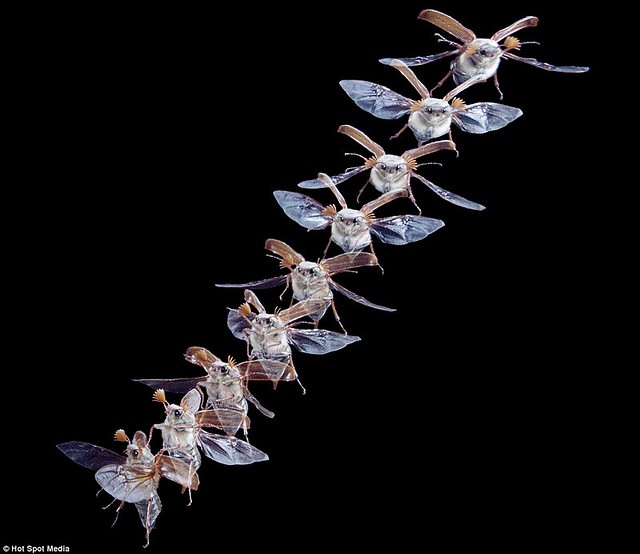 Incredible insects: A cockchafer beetle, otherwise called a may bug or spang beetle, is shot flying around the garden
Incredible insects: A cockchafer beetle, otherwise called a may bug or spang beetle, is shot flying around the gardenObserving cats landing on their feet and squirrels scurrying around a garden might seem like just an ordinary event, but one talented photographer has transformed these moments into artwork.
The animal loving photographer has gone to extraordinary lengths to capture birds, rodents and insects in motion.
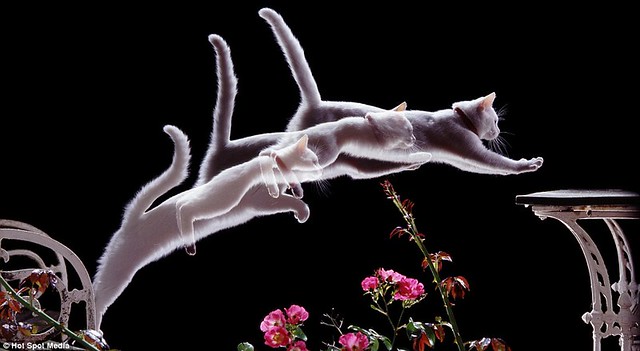 Playful cats: Photographer Kim Taylor captures a white cat, named Pyramus, leaping from a chair onto a table, taken at 50 millisecond intervals
Playful cats: Photographer Kim Taylor captures a white cat, named Pyramus, leaping from a chair onto a table, taken at 50 millisecond intervalsWith special homemade equipment, the 78-year-old from Surrey was able to capture his subjects in fractions of a second, giving a stunning 'strobe' effect on camera.
Using a special photographic technique that catches everything from the beat of a bird's wing to the flick of a squirrel's tail as it leaps through the air, Kim Taylor's stunning photos of an animal's ability to move from one place to another, also known as locomotion, is shown in awesome detail.
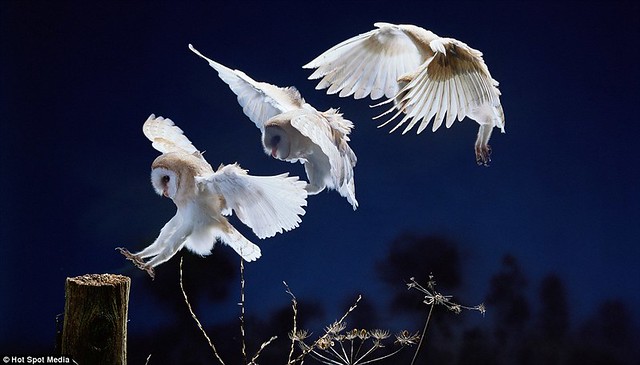 Landing owl: A beautiful white and beige owl lands is pictured landing on a wooden post in a Surrey garden
Landing owl: A beautiful white and beige owl lands is pictured landing on a wooden post in a Surrey gardenA rapidly-flashing light or strobe produces multiple images of a moving subject on a single photographic frame is a technique that has been around since the very early days of photography.
Legendary English photographer Eadweard Muybridge used this system to show the action of a galloping horse in the 1870s.
Mr Taylor was inspired to capture animals in motion by fellow Brit photographer Stephen Dalton who experimented with the technique in order to capture insects in flight.
 Fluttering feathers: A European robin takes off from a wooden post as the sun sets in Surrey
Fluttering feathers: A European robin takes off from a wooden post as the sun sets in SurreyHe said 'I didn't have any special equipment at the time so I had to design and build a special unit for the job.
'This required generating dangerously high voltage - 3,500 volts - and storing the energy in a bank of special and very heavy capacitors.
'The resulting equipment has three flash heads that flash simultaneously and produce nine flashes at rates varying from 2 per second to 500 per second.'
 Playful pony: A Welsh pony and her rider a photographed galloping around some stables at half second intervals
Playful pony: A Welsh pony and her rider a photographed galloping around some stables at half second intervals Before turning to photography, Mr Taylorworked as a biologist with the Ministry of Overseas Development and later with the Ministry of Agriculture.
He received no formal training in photography or electronics but was able to learn most of what he needed to perfect his works by trial and error.
Kim said: 'You can't afford too many errors when dealing with a lethally high voltage, however, I am still here.
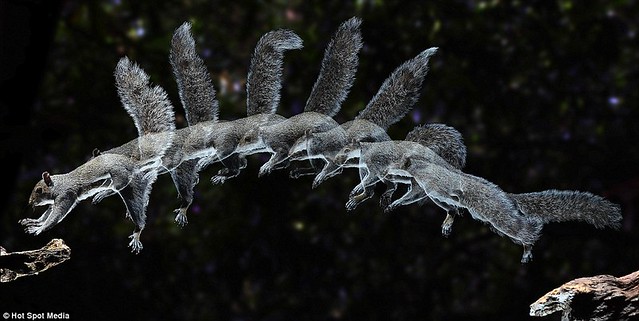 Scurrying squirrel: A grey squirrel is captured leaping around the garden using eight images taken at 40 millisecond intervals
Scurrying squirrel: A grey squirrel is captured leaping around the garden using eight images taken at 40 millisecond intervals'Because it's very heavy, the unit does not often get taken on location, so most of the shots have been done in my Surrey garden.
'Some of my early shots were of garden birds taking off and I had to make sure the timing was precise - just 25 to 35 milliseconds between flashes was necessary to ensure that the images were sufficiently separated.
'I used further timing unit to ensure that the bird was already beginning to take off by the time the first strobe flash fired.
'The shot of the robin at take off is one of my favourites but I also like the shots of insects in flight since they show how the wings are used to propel the insect into the air.
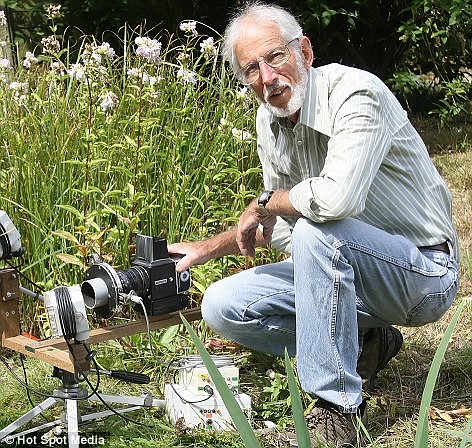
Talented photographer: Kim Taylor from Surrey poses with his equipment
'Digital photography and computerisation now allow series of images to be put together as if they represent a single event, whereas in reality, each image represents a separate event.
'But genuine strobe photography shows one event as it really happened.' Kim's pictures are so innovative that the BBC's One Show commissioned the photos of the squirrel which will be used on the programme this summer.'
source: dailymail














